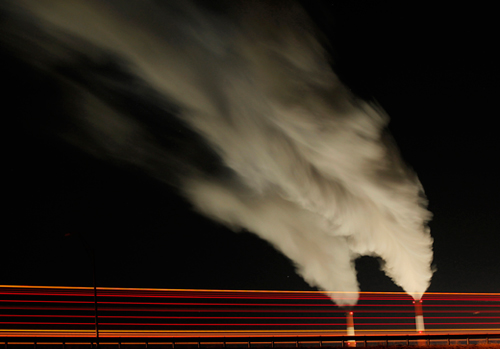
WASHINGTON (AP) — The Obama Administration’s hotly debated plan to reduce heat-trapping carbon dioxide from the nation’s power plants will save about 3,500 lives a year by cutting back on other types of pollution as well, a new independent study concludes.
A study from Harvard and Syracuse University calculates the decline in heart attacks and lung disease when soot and smog are reduced — an anticipated byproduct of the president’s proposed power plant rule, which aims to fight global warming by limiting carbon dioxide emissions.
Past studies have found that between 20,000 and 30,000 Americans die each year because of health problems from power plant air pollution, study authors and outside experts say. The study was published Monday in the peer-reviewed scientific journal Nature Climate Change.
The proposed EPA rule, which is not yet finalized, is complex and tailored to different states. It aims to reduce carbon dioxide emissions by 30 percent from 2005 levels by 2030. Study authors said their research, while not hewing to the Obama plan exactly, is quite close and comparable. The study also finds about the same number of deaths prevented by reducing soot and smog that the administration claimed when the plan was rolled out more than a year ago.
Some in Congress have been trying to block the regulation from going into effect, calling the plan a job-killer and an example of government overreach.
The study finds that the rule would eliminate an average of 3,500 deaths a year — a range of lives saved from 780 to 6,100 — with more than 1,000 of the lives saved in just four states that get lots of pollution from coal power plants: Pennsylvania, Ohio, Texas and Illinois. The new regulation would reduce hospitalizations by 1,000 a year and heart attacks by 220 a year, the study says.
Cleaning the air as part of reducing carbon dioxide has immediate and noticeable benefits, the authors said.
”There could be lives saved associated with the way we implement the policy,” said study lead author Charles Driscoll, an environmental engineering professor at Syracuse. ”Why not kill two birds with one stone if you can?”
Lab studies on animals show how soot and smog harm the cardiovascular and respiratory systems and epidemiological studies link tens of thousands of deaths each year to soot and smog pollution, said study co-author Joel Schwartz, a Harvard environmental epidemiologist. The study’s authors examined 2,417 power plants and used computer models to project and track their emissions.
The study was praised by outside academics, the Environmental Protection Agency and environmental advocacy groups. But officials in the energy industry called it costly and flawed.
”This is more than just an academic exercise to the tens of millions of Americans who depend on affordable, reliable electricity to power their homes and places of work every day,” said Laura Sheehan, senior vice president for the American Coalition for Clean Coal Electricity. ”For them, this is about their livelihoods. Coal provides nearly 40 percent of the nation’s electricity and its use is becoming cleaner all the time. And while these academics are hypothesizing about unprovable consequences, what’s known is that families are struggling to pay their monthly bills and companies are struggling to stay in business – and any increase in energy costs will unnecessarily burden them. ”
EPA, in a statement, said the study confirms their earlier research, which shows that for every dollar spent complying with the regulation, ”Americans will see up to $7 in health benefits.”
Three top science officials in the George W. Bush Administration who are now outside academics — George Gray at George Washington University, John D. Graham at Indiana University and Howard Frumkin at the University of Washington — praised the study to various degrees.
”This analysis is both sound and useful,” Gray, former EPA science chief and now director of risk science and public health, wrote in an email. ”The cool thing is the question they ask: What public health effects might occur due to changes in air pollutants as we act to reduce greenhouse gas emissions?”
Photo: In this 2012 file photo, smoke rises in this time exposure image from the stacks of the La Cygne Generating Station coal-fired power plant in La Cygne, Kan. Carbon dioxide pollution has increased steadily, by 60 percent, from 1992 to 2013. In 1992, the world spewed 24.9 billion tons of carbon dioxide, now it is 39.8 billion, according to scientists at the Global Carbon Project international consortium. (AP Photo/Charlie Riedel, File)










